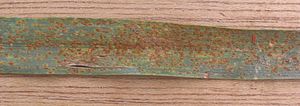Rust (fungus)
| Rusts | |
|---|---|
 |
|
| Puccinia recondita f.sp. tritici on wheat leaf | |
| Scientific classification | |
| Kingdom: | Fungi |
| Phylum: | Basidiomycota |
| Class: | Pucciniomycetes |
| Order: | Pucciniales |
| Families | |
Rusts are plant diseases caused by pathogenic fungi of the order Pucciniales (previously also known as Uredinales).
An estimated 168 rust genera and approximately 7000 species, more than half of which belong to the genus Puccinia, are currently accepted. Rust fungi are highly specialized parasites with several unique features.
A single species may produce up to five morphologically and cytologically distinct spore-producing structures viz., spermagonia, aecia, uredinia, telia, and basidia in successive stages of reproduction.
Unlike other plant pathogens, rust usually affects healthy and vigorously growing plants, so the infection is limited to plant parts such as leaves, petioles, tender shoots, stem, fruits, etc. Perennial systemic infection may cause deformities such as growth retardation, witch's broom, stem canker, hypertrophy of the affected tissues or formation of galls.
Plants with severe rust infection may appear stunted, chlorotic (yellowed), or otherwise discoloured. Rust sporulates on affected plant parts.
Rust is most commonly seen as coloured powder, composed of tiny aeciospores which land on vegetation producing pustules, or uredia, that form on the lower surfaces. During late spring or early summer, yellow orange or brown, hairlike or ligulate structures called telia grow on the leaves or emerge from bark of woody hosts such as Juniperus species. These telia produce teliospores which will germinate into aerial basidiospores, spreading and causing further infection.
The taxonomy of Pucciniales is complex and the darker coloured smuts can be mistaken for rust. Rusts are so named after the reddish rusty looking sori and the disease is usually noticed after rain.
The group is considered one of the most harmful pathogens to agriculture, horticulture and forestry. These fungi are major concerns and limiting factors for successful cultivation of agricultural and forestry crops. White pine blister rust, wheatstem rust, and coffee rust are examples of notoriously damaging, economically important rusts.
Rusts can produce up to five spores types during their life cycle
Rust fungi can be categorized by how many types of spores are produced during the life cycle. Fungi that produce all five spores (sometimes excluding pycniospores) are termed macrocyclic. Fungi that lack pycniospores and aeciospores in their life cycle are termed microcyclic and always have an autoecious life cycle. Demicyclic fungi delete the uredial (repeating) stage from the life cycle. Understanding the life cycles of rust fungi allows for proper disease management.
...
Wikipedia
